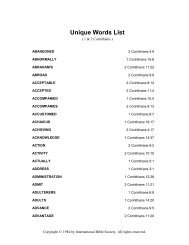FREE METHODIST YOUTH - Bible Quizzing - Study Tips & Resources
FREE METHODIST YOUTH - Bible Quizzing - Study Tips & Resources
FREE METHODIST YOUTH - Bible Quizzing - Study Tips & Resources
Create successful ePaper yourself
Turn your PDF publications into a flip-book with our unique Google optimized e-Paper software.
Note: The basic question words are: Who (Whom), What, When, Where, Why, How, For what reason, purpose,or cause. “For what Reason” is inter-changeable with “Why.” “Who” is interchangeable with “What”(although it is preferred that “Who” and “What” be used properly, of course).(ii) The prejump is completed correctly and extra accurate information not found in the answer is added, suchas references or clarifying modifiers of words to the question.(iii) The question has a list for an answer and the completion asks for as many or more parts of the list than thewritten question.(c) In ruling on the correctness of a completion of a question in a prejump, the quizmaster should take an approachof allowing the quizzer to show what he knows. If the completion of the question given by the quizzer wouldlead to the same answer written in the question, the quizmaster should rule “you may proceed” (making nospecial indication that this is a 117C situation) and allow the quizzer to attempt to answer the question. Thewritten answer must be contained within his verbal answer. If it is not, even though his answer may be adequatefor answering his question, he must be ruled “incorrect.” If the quizmaster rules incorrect, he must readthe question as written for the other team. If the team who prejumped first questions this procedure (whichthey can do under the appeal of procedure J-5), simply say, “This situation is covered by procedure I-3 (117c).”This rule cannot be used as a reason for challenging a ruling on the completion of the question. The followingare guidelines for quizmasters applying I-3 (117c), but are not a basis for any appeal of the acceptance of a questioncompletion:(1) The question must have the same number of parts. (118d)(2) A significant part of the answer must not be included in the question. (118b)(3) The answer to the written question must be included in the answer to the quizzer’s question. If any part ofthe written answer would not be required by the quizzer’s question, the completion should not be accepted.(4) The answer provided by the quizzer must answer the written question and his/her accepted question.(5) The quizzer’s question must be specific enough to be answered within 20 seconds. (129a)Note: There is still no appeal allowed on the completion of a question accepted under I-3 (117c).(d) Quizzers can not change what the quizmaster has already said in a question that is prejumped. The questionmust be completed by using what has already been said by the quizmaster.(e) It is acceptable for a quizzer to turn a regular question into a cross-chapter question by making it more general.Then the quizzer must answer the broader question by giving all answers to his/her question. However, thecompleted question must still have the same number of parts as the original.(f) If a quizzer jumps at such a place in a question where the question could be considered complete but accordingto the page is not complete, when asked to finish the question, the quizzer may ask the quizmaster, "Can that becomplete?" Following the principles of 117 C, the quizmaster can accept that as a prejump completion.(118) A Prejump is Incorrect when . . .(a) The correct question word (or its acceptable equivalent) is not given.(b) A key part of the answer has been placed in the completion of the question. The quizmaster must interpret howsignificant the "part of the answer" is. One or two words (or more) of the answer may be acceptable in the questionif it is not a significant part of the answer.(c) The question has not been given a proper completion, and key words or phrases have been omitted.(d) More or less parts have been given than were in the original (written question), such as a 2-part question for a3-part question etc.(e) The question has a list for an answer and the completion asks for fewer parts of the list than the written question.(f) The completion includes limiters such as chapters, verses, sentences or paragraphs, such as "...and what is saidin the rest of this paragraph?" or when the completion contains such words as "and what else is true?"I-4: Appeals, Infractions, Etc.(119) An appeal shall be accepted only if the quizmaster realizes that the original ruling was evidently in error withthe rules. The rules specific to the type of appeal being given should be referred to during deliberations. The quizmastershould listen carefully to both appeal and rebuttal, consult the rules, and rule fairly and impartially. Warnings and Infractionsshould not be given lightly or without cause, but neither should they be withheld if one is due.(119A) A question is discarded and a substitute question read for both sides when . . .(a) The question as written has no answer (or none that can be said in 20 seconds).(b) The question has been read by the quizmaster in violation of the legal reading guidelines given in G-2.





